Boost your ad revenue with personalized sponsored listings, powered by Miso
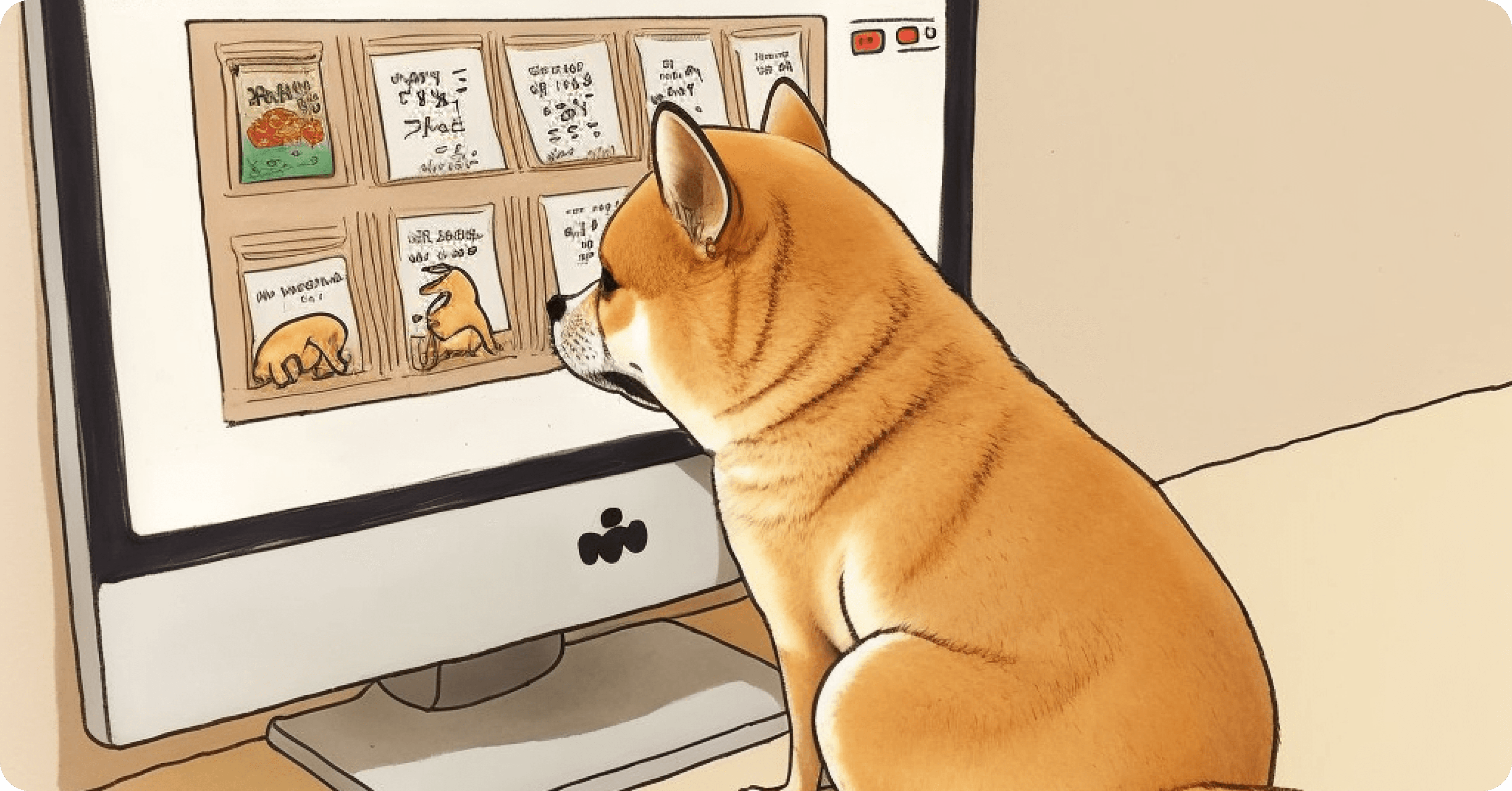
Sponsored Listings (a.k.a Promoted Listings or Sponsored Products) are becoming more and more ubiquitous on the web, and for good reason. Unlike the traditional product promotion route of leveraging third-party ad networks, sponsored listings are first-party ad units that appear organically on your site, mixed in with similar un-sponsored listings, without disrupting the shopping flow. Apart from sporting a small “sponsored” tag, it can be difficult to even discern a sponsored listing from an un-sponsored one. Take, for example, the search results of “running shoes” from Amazon:
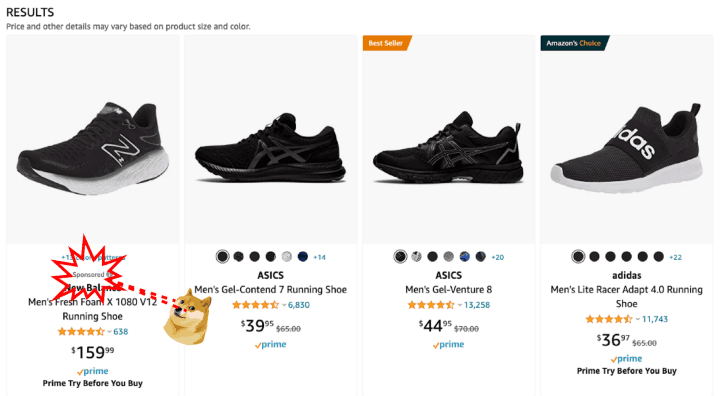
This type of product promotion usually doesn’t trigger a negative immune response that third-party ads have a reputation of doing. Unlike those third-party ads, clicking on the product tile doesn’t take me away from the Amazon domain to another site, which would otherwise disrupt my shopping flow. Also, New Balance is a popular, vetted brand that Amazon already works with so there’s an inherent level of brand trust that carries over from my trust towards Amazon as a whole. Finally, the ad itself is very relevant to what I was looking for in the first place and is actually a good option for me.
Speaking of Amazon, their ad revenue from sponsored listings just hit a record $31 billion last year.
When executed well, sponsored listings present a win-win-win opportunity:
- Sponsored listings are a very high margin, low risk revenue stream to diversify the revenue base for the e-commerce sites
- The brands that bid on their ad space are gaining positive ROI from the increased product visibility and conversions
- Consumers are given recommendations for products that are relevant to them, which they may not have discovered otherwise
Below are some more examples of sites that make use of sponsored listings:
- Large “everything” retailers like Macy’s carry tens of thousands of products from hundreds of brands. Brands can pay them on a ‘per click’ or ‘per impression’ basis so that their products appear closer to the top of search results. This is analogous to the end cap placement you would find in brick-and-mortar stores. In the example below, sponsored listings are denoted with a “Sponsored” tag:
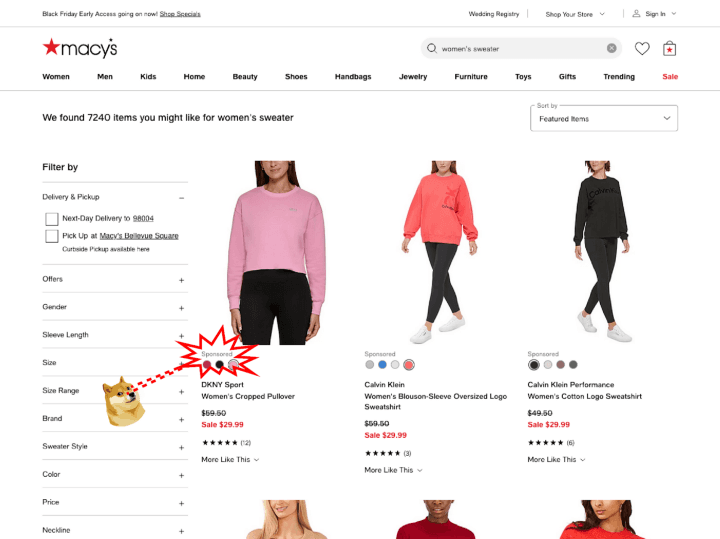
- Similar to large retailers, user-driven marketplaces like eBay offer individual sellers the ability to boost their listings to the top of the search results page for an additional fee (usually a percentage of the sale price). On a site with 1.7 billion active listings, sellers need all the additional visibility they can get to quickly move their products. While we’re on the subject of eBay, they actually added a ton of new features to their Promoted Listings program earlier this year, offering pay-per-click pricing options and the ability to promote auctions (in addition to the standard “Buy it now” listings).
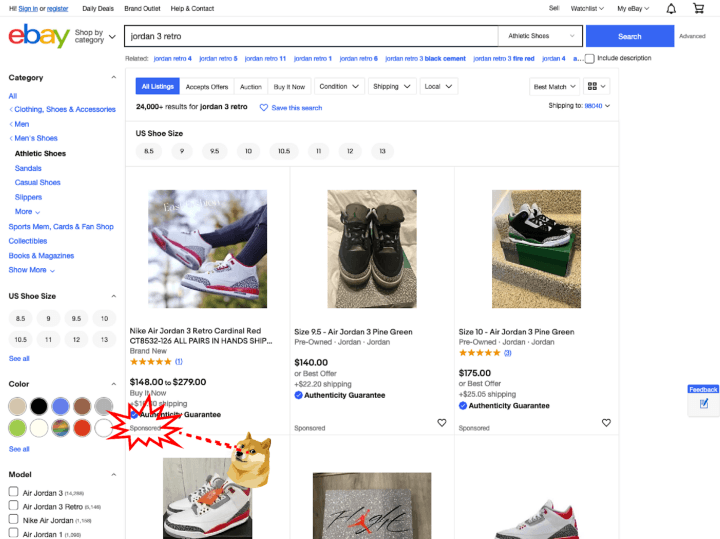
- Sponsored listings aren’t unique to retailers and marketplaces — travel sites like Hotels.com and restaurant aggregates like Yelp offer a paid service for businesses to appear at the top of search results, significantly increasing their patronage. In the screenshot below, the sponsored listings are marked as “Ad” (by the way, The Graduate Seattle hotel has a unique rooftop bar called Mountaineering Club with incredible views of Lake Union, Mt. Rainier, and the Olympics).
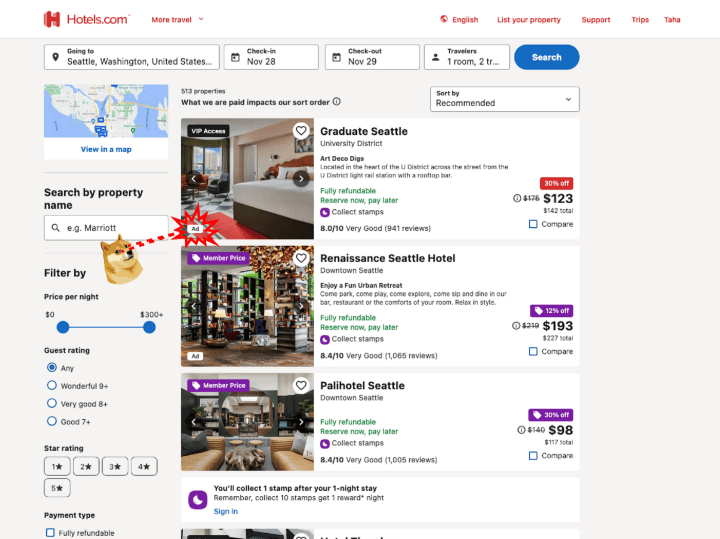
A multi-headed conundrum
As I mentioned earlier, when executed well, sponsored listings are a win-win-win for e-commerce sites, brands, and customers. But to really stick the landing on this triple axel, there are several competing objectives that product teams need to account for:
Maintaining user relevancy
The single most important goal of sponsored listings is to show relevant products to the customer. Driving click-throughs and conversions is kind of the whole point, right? The sponsored products that are shown should be relevant to an individual user (based on browsing history, order history, items in their cart, etc.) or relevant to similar products on a search results page. Notice how in the Amazon sneaker example, the sponsored New Balance shoes and the three others pretty much look identical (much to the chagrin of our sneakerhead-in-recovery CEO, Lucky). On the other hand, it can be very jarring and off-putting when seemingly random sponsored products show up in results. Here’s what I mean:
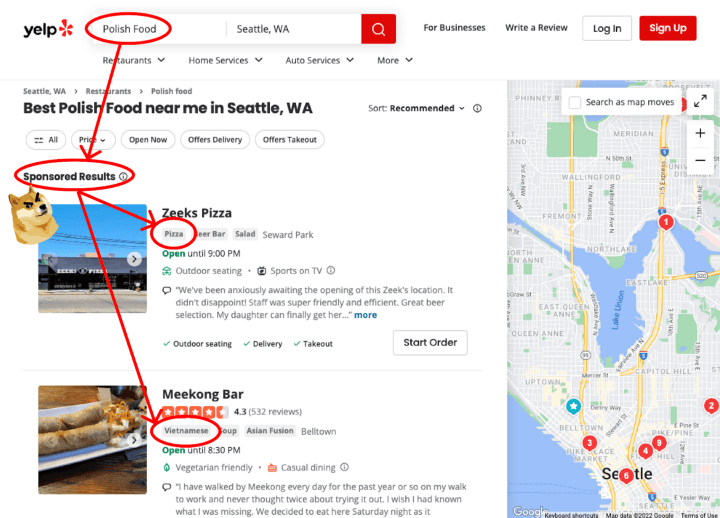
As a Chicago-native who moved to Seattle a few years ago, I still get regular cravings for pierogi and golabki. A pizza place and Vietnamese restaurant aren’t remotely close to what I’m looking for at the moment.
Don’t cannibalize sales
There should be a diverse mix of product listings that are shown to the customer — sponsored, popular, trending, higher margin, higher priced. Having too much of any one type can clutter the UX and overwhelm the customer, ultimately negatively impacting your core AOV. Imagine if the top 10 or 15 results were all sponsored products but they weren’t as high-margin as some of your unsponsored products. Would the earned bid price justify the lower margin? These are difficult but necessary decisions that need to be weighed against each other.
Maintaining bidder retention
Brands are the ones bidding on the sponsored listing ad placements, making this revenue stream possible in the first place. It’s vital that they receive a positive ROI so they continue returning to your site to make repeated bids. This means increased impressions, click-throughs, and sales of sponsored products.
If these goals seem at odds with each other, it’s because they can be. This is a classic multi-objective optimization problem, and we’ve been working on a solution here at Miso.
Miso’s approach to optimizing sponsored listings
Here’s the million dollar question you’re probably wondering about if you’ve made it this far: How do I know which sponsored products to put where to keep our customers and brands engaged while also continuing to grow my revenue?
There’s a lot to unpack here, so let’s start by answering a more foundational question: How does Miso recommend anything in the first place?
Here’s a helpful diagram:
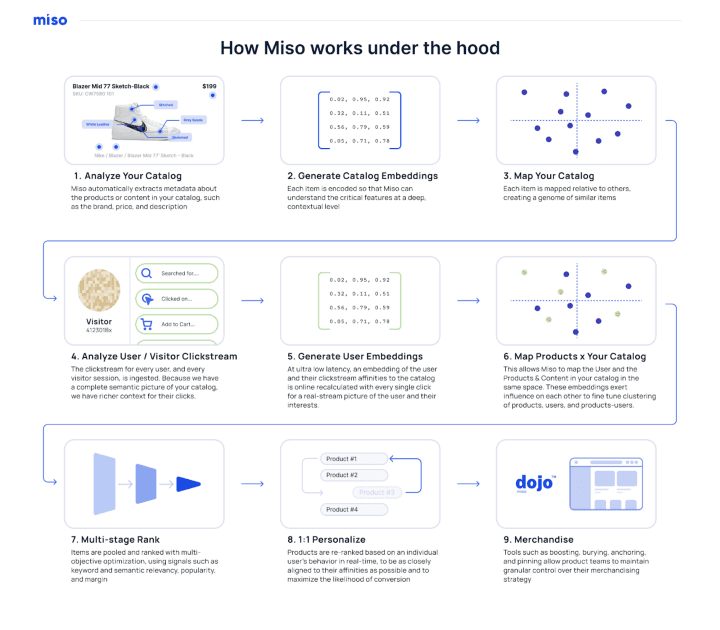
For the sake of brevity, I’ll attempt to paraphrase (our Engineering team can suddenly sense a disturbance in the force…). Miso generates embeddings, which can be thought of as a low-dimensional, numerical representation of an object. An object in this context can be a product, a user/anonymous visitor, or a log of their clickstream. Going from step 1 to step 2 in the above diagram, you can see how the product metadata of a Nike sneaker was encoded into a matrix. The embedding itself isn’t really meant to be human-readable (I can’t tell you how a 0.02 is different from a 0.56 or why there are X numbers) but the neural network knows exactly how to interpret it.
All the embeddings are then mapped within the same vector space so Miso can compare products to products, users to users, and users to products. In other words, this method allows Miso to say things like, “For a given user X, products 1, 2, and 3 are most relevant to them”. For each individual user, anonymous or signed-in, Miso outputs a personalized and ordered set of products that are most likely to result in a conversion, calculated in real-time, and based on their in-session behavioral patterns and when applicable, semantic relevance to a search query. These rankings are typically further fine-tuned using a multi-objective ranking optimization algorithm to maximize metrics like AOV, GMV, and conversion rates.
For sponsored listings, Miso further re-ranks the products based on the bid price (the cost per click fee that a bidder pays to the e-commerce site for a clickthrough). It looks something like this:

In other words, for a given user i, and a given product j, the sponsored listing score is the probability that a particular user clicks on a particular product, weighted by some function of the bid price for that product. Typically, predefined sponsored listing slots on the front-end UX are then populated based on the ordering and candidate pool generated by Miso.
As for the unknown function of the bid price, we can’t really say ahead of time what it will be, as it heavily varies from site to site. The function might be linear, exponential, or even logarithmic. For each individual use-case, we first make an estimation using an offline evaluation process and then use our in-house A/B testing functionality and team of data scientists to empirically iterate towards the optimal bid price weighting function.
Of course, in cases where a brand requires a specific product in a top spot (even if it’s potentially underperforming), Miso’s sponsored listing ordering optimization can be overridden using our merchandising tools.
A note about static vs dynamic sponsored listing slots
The most common front-end implementation of sponsored listings is to have sponsored product tiles at predefined locations. That might look like the first three slots on a search engine results page (SERP), or the second row of a category page, or the last slot in a Frequently Bought Together product shelf. It’s totally up to you. Miso only provides the collection of products and the order in which to populate the product tiles, guaranteeing relevance to the user and optimization for the bid price.
On the more extreme end of the spectrum, we can support a business model (and accordingly designed UI) where everything receives the same treatment as a sponsored listing. Rather than having predefined slots, you can set a default bid price of 1 and organically show a mix of sponsored and unsponsored listings that are ordered in such a way that maximizes both AOV and ad revenue gained from brands.
It seems wild, but we actually worked with a very large retailer that used the exact strategy described above. When they turned on Miso’s sponsored listings functionality, their conversion rate increased ~10% over only a two week period.
Too much of a good thing?
As the saying goes, “too much of anything is bad for you” and it’s no different with sponsored listings. Inundating your customers with sponsored listings can be off putting at best and at worst, can lead to antitrust lawsuits (Tim O’Reilly wrote a great article on this topic here). It can make your product pages and search results seem frustrating for brands that want to compete for impressions on a more even battlefield and disingenuous for consumers, as it can override what’s popular, trending, highly reviewed, or most relevant to them.
So now Amazon has 7 sponsored ad listings ahead of the number one product organically. I guess this means we should stop trying to rank our products and just focus on Sponsored ads since they want to fill the page with them. pic.twitter.com/MMXYHi76ja
— Brandon Michael Clark (@wallshark84) March 10, 2021
At Miso, we work closely with our partners to help design sponsored listing strategies that maintain this delicate balance. And similar to our multi-objective ranking optimization process for ranking potential sponsored listing placements, we utilize our in-house A/B testing tool to find the best strategy for your organization.
Closing Thoughts
Sponsored listings are an exciting revenue generator for many e-commerce sites. In fact, some retailers, like Instacart, have already started developing their own ML-based approaches to sponsored listings. We’ve been very deliberate in designing our approach so that your customers only see listings that are relevant to them and are likely to result in conversions — keeping the brands bidding on your ad space coming back.
Even putting the ad revenue aside, there are plenty of other reasons you might want to consider sponsored listings in lieu of traditional 3rd party banner ads:
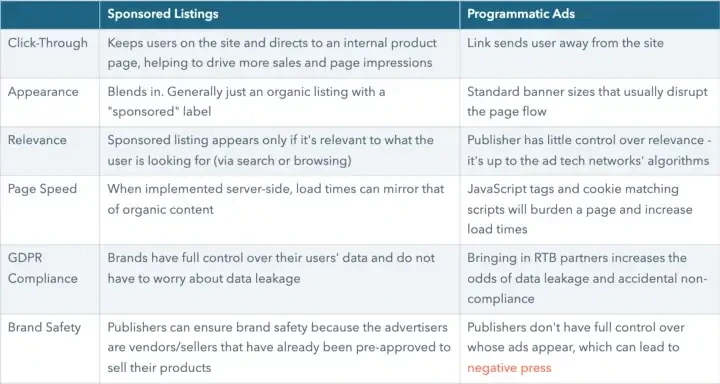
And finally, you’ve probably already heard that third-party cookies are being phased out around the web, ramping up the urgency for e-commerce retailers, marketplaces, and content media to find creative ways to account for the impending loss of third party ad revenue.
I think that’s all for now. As always, if you found our approach to sponsored listings to be intriguing and want to learn more (or want us to unpack another topic), we’re happy to chat with your team, 1:1. Just send us a note at hello@askmiso.com or get in touch with us via our contact form.